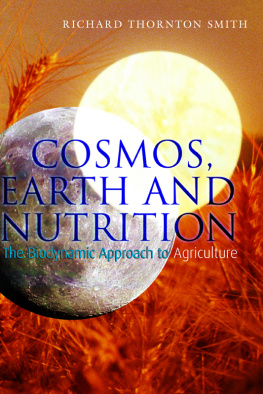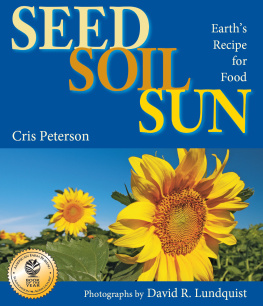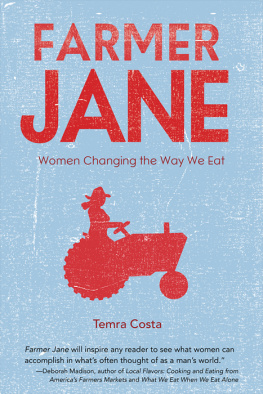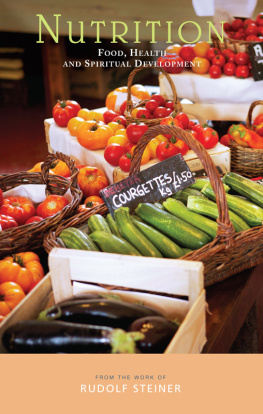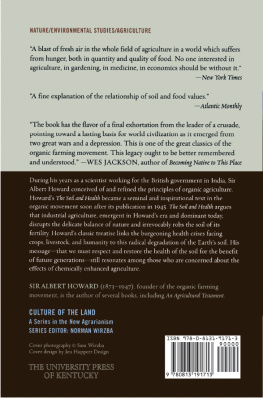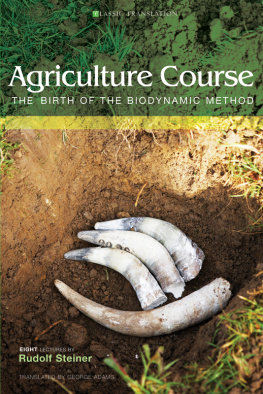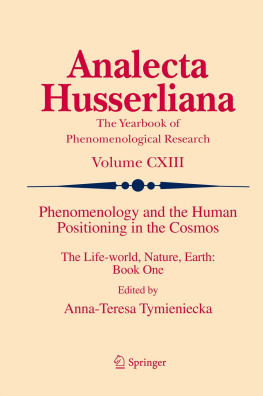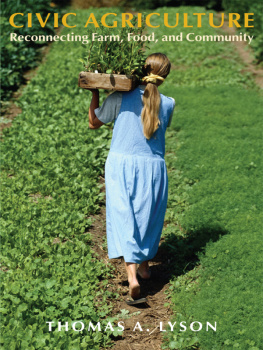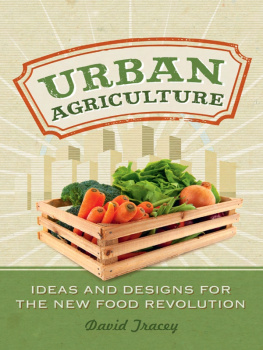DR RICHARD THORNTON SMITH was formerly a geography professor at the University of Leeds, specializing in soil science environment and conservation. Widely travelled, he has a longstanding interest in indigenous and sustainable farming. He was introduced to the work of Rudolf Steiner at an early age, although his full involvement with biodynamics dates from 1990 when he began to participate in training programmes and workshops at Emerson College, Sussex. In 1996 he began a biodynamic extension programme in Sri Lanka, for which he published a book, updated in 2007. Since 2001 he has been an inspector for the Biodynamic Associations Demeter and Organic Certification in the UK. In 2003 he produced an edited selection of Steiners work relating to agriculture. He is currently a council member of the Biodynamic Agricultural Association, and lives in Ross-on-Wye Herefordshire.
COSMOS, EARTH AND
NUTRITION
The Biodynamic Approach to Agriculture
Richard Thornton Smith
Sophia Books
Sophia Books
Hillside House, The Square
Forest Row, RH18 5ES
www.rudolfsteinerpress.com
Published by Rudolf Steiner Press 2012
Richard Thornton Smith
The moral right of the authors have been asserted under the Copyright, Designs and Patents Act, 1988
All rights reserved. No part of this publication may be reproduced, stored in a retrieval system, or transmitted, in any form or by any means, electronic, mechanical, photocopying or otherwise, without the prior permission of the publishers
A catalogue record for this book is available from the British Library
ISBN 978 1 85584 319 6
Cover by Andrew Morgan Design
Typeset by DP Photosetting, Neath, West Glamorgan
Contents
Preface
There has been growing interest in biodynamics in recent years. For a long time the organic farming and gardening movement was dismissed as marginal and alternative, but escalating concerns about the environment, health, food quality, animal welfare and related issues have raised the profile of organics in a way few could have imagined 30 years ago. As a branch of organic agriculture, it is scarcely surprising that biodynamics has emerged more into public consciousness.
Biodynamics was never narrowly focused on agricultural techniques. It was conceived as a new way of thinking about farming, nutrition and the world of nature. Originating from a series of eight lectures on agriculture given by Dr Rudolf Steiner in 1924, it offers a new holistic outlook that frees agriculture and science from the limits of a purely materialist philosophy.
Like others before it, the present book supports practical biodynamic farming and gardening. Those already involved with biodynamics should find among its broad range of topics much to deepen their understanding of the subject. They will also detect the authors concern to promote innovation and for biodynamics to move with the times. Those new to biodynamics, but perhaps already committed to an organic philosophy, may have little idea of Rudolf Steiners immense contribution to knowledge. A major task of this book is therefore to set out the fundamentals on which not only biodynamics but also the wider organic movement depend. To meet this need, the book aims wherever possible to create a bridge between mainstream science and Steiners insights and suggestions, and to offer the wider organic and agro-ecological movement a firmer basis for acknowledging biodynamic concepts.
While Steiners Agriculture Course remains the cornerstone, those working with biodynamics have found it essential to study his other lectures and books to gain better foothold with the content of the agriculture lectures, and to extend their scope. This is a long, ongoing process. Yet there is an urgency about getting to grips with the current disruptions to climatic, ecological and economic conditions, and this concern has provided the motivation for the present volume.
Considered as a group, the first four chapters lay the foundations. I first place biodynamics in the context of holistic forms of agriculture, outlining the cultural fault-line with conventional agriculture and the kinship of biodynamics with organic traditions and the wider agro-ecological movement. Chapters explore themes from the Agriculture Course-the cosmic dimension, the farm organism and the role of the soil. Crucial to the aim of this book is that we adopt a more enlightened view of how the farm or garden manages the interplay of earth and cosmos, and how soil, too often regarded as the most mundane of substances, truly sustains the whole of life.
Having widened our view of nature, the principal biodynamic practices are presented in Chapters enters into the special character of water, the most vital of substances supporting life, and the way in which it is used and treated in biodynamic procedures.
The last four chapters, in their different ways, all connect with the human being. Chapter , which tackles the immense subject of food and health, will represent for many people the prime mission of biodynamic agriculture and is justification alone for probing the hidden pathways of nature explored in this book. Through discussion of modern health problems, the chapter confirms the wisdom of a holistic approach to nutrition.
Chapter introduces the social element of agriculture. So far of limited impact, community involvement with agriculture seems set to gain momentum as pressure builds for more local production and consumption networks. In this field we highlight experiences on a number of pioneering biodynamic farms. The final chapter reviews the dramatic nature of current circumstances, highlighting concerns about food cost and security. It discusses issues which confront the organic movement and the challenge for biodynamics to be more flexible if it is to gain impetus. It points to the need for new relationships between society, the land and planet earth, all of which are inspired by spiritual ideals.
As the books chapters are written with a progression of ideas in mind there will be some benefit reading it that way. However, they can also be regarded as separate essays, and generous cross-references are provided. It is hoped that in this way, and with the provision of numbered notes, the book will offer useful study material.
Acknowledgements
This book is dedicated to my mother, Winifred Smith, who introduced me both to gardening and to the work of Rudolf Steiner.
I offer thanks to those with whom I have been able to work and discuss biodynamics, notably to my former partner Freya Schikorr and to Matthias Gupin. These include colleagues and friends within the Bio-dynamic Association as well as those I have visited in the course of inspection work with Demeter UK. Friends and acquaintances overseas, notably in Sri Lanka, have helped broaden my cultural awareness.
Those who have opened doors or played a part in my work within the biodynamic movement deserve mention. I would especially acknowledge Jimmy Anderson, Pauline Anderson, Joan L. Brinch, Timothy Brink, Alan Brockman, David Clement, Anthony Kaye, Hans-Gnther Kern, Manfred Klett, Walter Rudert, Patricia Thompson and Olive Whicher.
I am grateful to Dr Margaret Colquhoun and Bernard Jarman for contributing Chapters . Others have offered valuable comments, including Alan Brockman, Peter Brinch, Wendy Cook, Bernard Jarman, Hans-Gnther Kern, Dr Nicholas Kollerstrom, Paul and Anny Knig, Dr William Smith and Hans Steenbergen. Finally, various suggestions for improvement have arisen during the editorial process.
1. The Foundations of Holistic Agriculture
A historical context can help readers assess the distinctive contribution that biodynamics offers for understanding the natural world. Here we shall review how people in the past approached agriculture, and what has happened as a result of using agrochemicals. Organic farming will then be considered, noting the many benefits this can bring, before finally introducing biodynamics.
Next page
